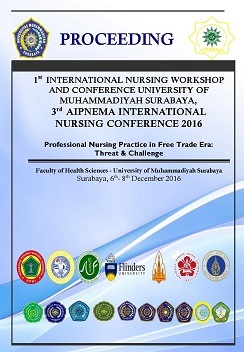Relationship Between Behavioral Handwashing With Diarrhea Incidence of School Age Children
Abstrak
Introduction:The Relationship between Children's Behavior Handwashing with Diarrhea Incident at School Age Malang. Handwashing behavior Considered unimportant thing in the community, whereas Handwashing can Contribute to improve the health status of the community. School-age children have the habit paying less attention to the need for Handwashing in everyday, especially when in the school environment. The behavior could effect and Contribute to the occurrence of diarrhea disease. Handswashing is the most important fundamental technique in the prevention and control of infection transmission.Methods: This study was the correlation analysis. Research subjects are of school age children in Malang with cluster sampling technique that is equal to 300 respondents. Data analysis is using Spearman. Results:school age children Handwashing behavior in Malang are in good categories (53.7%), moderate (41.7%) and poorly (4, 6%). While the incidence of diarrhea in children of school age in Malang in the low category (59.3%), moderate (37.7%) and high (3%). Relationship between Handwashing and diarrhea incidence Obtained p value = 0.000 is smaller than 0:05 and r = 0792, Conclusion:statistically it Proves that there was a significant relationship between the incidence of diarrhea and Handwashing.
Â
Keywords : Behavioral Handwashing, Diarrhea IncidenceReferensi
Adisasmito, W. (June 2007). The risk factors of diarrhea in infants and young children in Indonesia: systematic review of academic research field of public health. MakaraHealth,(11) 1, 1-10
Burton, M., Cobb, E., Donachie, P., Judah, G., Curtis , V & Schmidit, W. (2011). The effect of Handwashing with water or soap on bacterial contamination of hands. Int. J. Environ. Res. PublicHealth,8, 97-104. doi: 10.3390 / ijerph8010097
Chittleborough, CR, Nicholson, AL, Young, E., Bell, S & Campbell, R. (2013). Implementation of an educational intervention improve hand washing in primary schools: evaluation process within a randomized controlled trial. BMC PublicHealth,13: 757, 2-11
Department of Health of the Republic of Indonesia. (2008). National strategy: total sanitation based society. Jakarta: Ministry of Health
Fazriyati, W. (2013). Habits CTPS press nosocomial infections inhospitals. Http://health.kompas.com/read/2013/09/26/1643106/Kebiasaan.CTPS.di.RS.Tekan.Inf eksi.Nosokomial.downloaded, November 1, 2013
the Ministry of Health. (2011). Diarrhea situation in Indonesia. Bulletin Window Data and Information Health (Quarter II), 1-39
Luby, SP, Agboatwalla, M., Bowen, A., Kenah, E., Sharker, Y & Hoekstra, RM (2009). Difficulties in Maintaining Improved Handwashing Behavior, Karachi, Pakistan. Am. J. Trop. Med.Hyg,81 (1), 140-145
Luby, SP, Halder, AK, Tronchet, C., Akhter, S., Bhuiya, A & Johnston, RB (2009). Household Characteristics Associated with Handwashing with Soap in Rural Bangladesh. Am. J. Trop. Med.Hyg,81 (5), 882-887. doi: 10.4269 / ajtmh.2009.09-0031
Luby, SP, Halder, AK, Huda, TMN, Unicomb, L & Johnston, RB (2011). Using child health outcomes to identify effective measures of Handwashing. Am. J. Trop. Med.Hyg,85 (5), 882-892. doi: 10.4269 / ajtmh.2011.11-0142
Mayasari, FF 2012. Hand Washing Behavior Differences between SD Kids to Kids Urban
Rural SD. Scientific work is not published. Terrain: The University of North Sumatra
Mikail, B. (2011). Hand washing is still low toxicity. http: // health .kompas.com / read / 2011/09/29/17324045 / Kebiasaan.Cuci.Tangan.Masih.Rendah. Downloaded, 01 november 2013
Pickering, AJ, Boehm, AB, Mwanjali, M & Davis, J. (2010). Efficacy of waterless hand hygiene Compared with Handwashing with soap: a field study in Dar es Salaam, Tanzania Am. J. Trop. Med.Hyg.,82 (2), 270-278. doi: 10.4269 / ajtmh.2010.09-0220
Potter, PA & Perry, AG (2005). Textbooks fundamentals of nursing:concepts, processes, andpractices.Issue 4. Jakarta: EGC
Rabbi, ES & Dey, NC (2013). Exploring the gap between hand washing knowledge and practices in Bangladesh: a cross-sectional comparative study. BMC PublicHealth,13:89, 2-7
Republika online. 2012. Prevent Diarrhea with Handwashing. http://www.republika.co.id/berita/gaya-hidup/info-sehat/12/12/31/mfwf6b- cegah-diare-dengan-cuci-tangan.accessed on 13 November 2013
Rosidi, A., Handarsari, E., Mahmudah, M. 2010. Relationships handwashing and sanitation of food with the incidence of diarrhea in children of public school districts Kedungwuni Podo 2 Pekalongan district. A society should KesehatIndones,(6) 1, 76-84
Schmidt, WP., et al. (2009). Determinants of Handwashing practices in Kenya: the role of media exposure, poverty and infrastructure. Tropical Medicine and International Health, (14), 12, 1534-1541 doi: 10.1111 / j.1365-3156.2009.02404.x
Vindigni, SM, Riley , PL & Jhung, M. (2011). Systematic review: Handwashing behavior in low-to middle-income countries: outcome measures and maintenance behavior. Tropical Medicine and InternationalHealth,(16) 4, 466-477. Doi: 10.1111 / j.1365-3156.2010.02720.x






